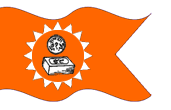
![]()
PAGE 5
Maharaja Agrasen, performed many yagnas (sacrifices) for the prosperity of his people. In those days, performing a yagna was a symbol of prosperity. During one such yagna, Maharaja Agrasen noticed that a horse that had been brought to be sacrificed was trying hard to get away from the sacrificial altar. Maharaja Agrasen was filled with pity and thought about what prosperity can be achieved by sacrificing mute animals. The idea of Ahimsa came into Maharaja Agrasen's mind, and the King discussed it with his ministers. The ministers advised Maharaja Agrasen that Ahimsa could be considered by neighboring kingdoms as a sign of weakness and encourage them to attack Agroha. Maharaja Agrasen felt that putting an end to violence and injustice does not show weakness. Thus, he proclaimed that there would be no violence and killing of animals in his kingdom.
Maharaja Agrasen established the republican state of Agroha. Agroha consisted of 18 state units. The head of each state unit was given a Gotra. All the residents of that particular state unit were identified by that Gotra. It was maintained by Maharaja Agrasen that a nupital alliance could not take place in the same Gotra. That is a girl of "Goel" Gotra could not marry a "Goel boy"', but could be married in any of the other 17 Gotra. This rule enunciated by Maharaja Agrasen promoted harmony and brotherhood among all the 18 Gotra represented by state units. This facilitated promotion of unity and nationalism among the state units. And gave the flag to here Kingdom .

 Flag has 18
inch width and 27 inch lenght , Flag has
V-shape Cut of 9 inch in front , Suryavamshi symbol of Surya in flag because
Maharaja Agrasen
is son of Suryavamshi , Surya have 18 representation of 18 gotra , One Brick and One Rupees in Flag represent
Maharaja Agrasen
, Flag has color of Saffron symbol of non-violence and Surya
, brick & rupees in color of Silver.However, his belief in
nonviolence did not mean non-resistance to oppression,rather he promoted self
defence. According to him self protection and national defence were not the task
of only kshatryas - the warrior caste, rather it is the duty of each
citizen to protect and safeguard his motherland.The ideas of Equality, Socialism
and non-violence propounded by Maharaja Agrasen 5000 years back form the spirit
of the present Constitution of India. But, we Indians have not been able to
cultivate these ideals into our lives, they remain simply words in our
constitution. It lies upon us now to adopt these ideals in our lives as a
tribute to our progenitor.
Flag has 18
inch width and 27 inch lenght , Flag has
V-shape Cut of 9 inch in front , Suryavamshi symbol of Surya in flag because
Maharaja Agrasen
is son of Suryavamshi , Surya have 18 representation of 18 gotra , One Brick and One Rupees in Flag represent
Maharaja Agrasen
, Flag has color of Saffron symbol of non-violence and Surya
, brick & rupees in color of Silver.However, his belief in
nonviolence did not mean non-resistance to oppression,rather he promoted self
defence. According to him self protection and national defence were not the task
of only kshatryas - the warrior caste, rather it is the duty of each
citizen to protect and safeguard his motherland.The ideas of Equality, Socialism
and non-violence propounded by Maharaja Agrasen 5000 years back form the spirit
of the present Constitution of India. But, we Indians have not been able to
cultivate these ideals into our lives, they remain simply words in our
constitution. It lies upon us now to adopt these ideals in our lives as a
tribute to our progenitor.






